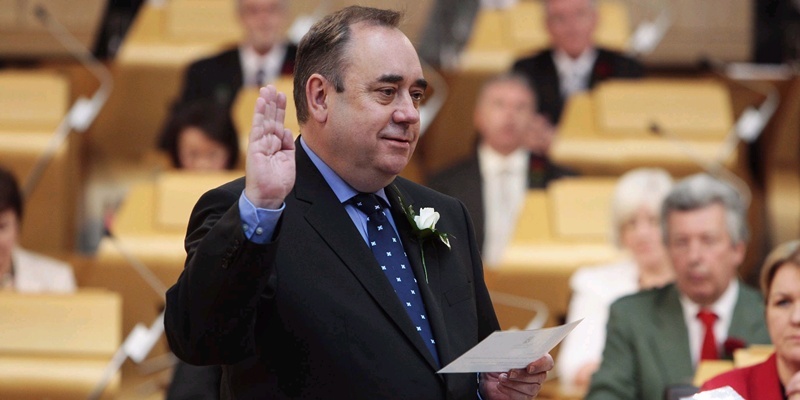The shape of the Scottish Government will become clear this week when Alex Salmond is reinstalled as first minister.
That will take place tomorrow almost two weeks after the landslide election result that guaranteed the SNP leader would receive the parliamentary support required to stay in the role.
With the Nationalists now enjoying a majority of eight MSPs in the 129-seat parliament, the vote will be a formality. Once it has been completed, attention will turn to the make-up of Mr Salmond’s ministerial team, with the ministerial and junior minister appointments expected to be revealed on Thursday.
The SNP has already confirmed Richard Lochhead will return to the post of rural affairs secretary after winning the support of key agriculture figures during his four years in the role and sources close to Mr Salmond have suggested it is unlikely many major changes will be made to the cabinet positions held prior to the election.
The strength of their front-bench team was one of the key strands of the Nationalists’ election campaign and it is thought they will look to maintain consistency in the majority of roles. That should see Nicola Sturgeon return as health secretary, Michael Russell keep the education brief, Kenny MacAskill continue at justice and John Swinney stay on in finance.
However, with 22 more MSPs in the SNP camp than in the previous parliament, Mr Salmond may be tempted to break up some of the ministerial briefs to share the workload. With the Commonwealth Games being held in Glasgow in 2014, for example, there may be an argument for splitting the public health and sport portfolios currently held by Dundee City East MSP Shona Robison.
The retiring Jim Mather will also need replaced as the enterprise, energy and tourism minister. It is possible that role could be shared by two or even three new junior ministers.
Once the changes have been approved by the parliament and signed off by the Queen, focus will turn to the SNP’s agenda for government. After four years of minority government when the SNP was unable to get any legislation through the parliament without the support of the other parties there has been a sea change in Scottish governance.
The SNP has already shown its willingness to use its majority to force through measures in the face of opposition with the election of Mid Fife and Glenrothes MSP Tricia Marwick as presiding officer. It is likely the party will move to force through a number of measures fairly quickly, especially as its dominance is further strengthened by the current disarray of the opposition parties.
Scottish Labour in particular looks set for a long process of back-biting, blame allocating and top-to-bottom restructuring before it can re-emerge as a credible opposition.
On the policy front, much has been made of the inevitable referendum on independence but Mr Salmond has confirmed that he will not bring the measure forward until the second half of the parliament. Instead he is focusing on strengthening up the terms of the Scotland Bill, which is currently passing through Westminster and would give Holyrood more devolved powers.
Continued…
The SNP has consistently been critical of the proposals and Mr Salmond is demanding the bill be strengthened to include borrowing powers, control over corporation tax and the revenues raised in Scotland by the Crown Estate. Control over the Crown Estate which controls the seabed up to 12 miles from the coast is considered particularly important for places like Dundee and Methil, which are hoping to cash in on the renewable energy boom.
In terms of what can be achieved with Holyrood’s existing powers, meanwhile, the SNP has pledged to reintroduce legislation to set a minimum price for alcohol in an effort to combat problem drinking. The measure was a key part of last year’s alcohol bill but was rejected by the opposition parties. Many observers felt the Nationalists had won the argument on the issue in the original debate and it should not take long for it to reappear at Holyrood.
A more problematic policy area for Mr Salmond, however, will be how to solve the issue of higher education funding. The SNP made a manifesto pledge that students would not have to contribute to the costs of their education, calculating the funding gap between Scotland and England – where tuition fees are being introduced – would be about £93 million. However, other studies have put that figure as high as £360 million and it is not immediately clear where the money will come from at a time of tightening budgets.
The new Scottish Government will also need to fund a further five years of the council tax freeze, a key manifesto pledge that will have cost more than £3 billion by the end of the parliamentary term. It has also pledged to protect spending on the NHS, making the books more difficult to balance.
Further down the line, the SNP will also need to come to a decision on the future shape and size of the police and fire service. The Nationalists have already said they favour a single fire service but the future of the current eight police forces was an issue they fudged prior to the election.
The powerful Scottish Police Federation, which represents rank-and-file police officers, has already voted to oppose any moves towards a single police force. If Mr MacAskill is reinstalled as justice minister he may have his work cut out to come to a suitable and cost-effective arrangement.
In further financial worries, the SNP has admitted it will have to negotiate pay restraint in the public sector if compulsory redundancies are to be avoided. The relevant unions have already indicated their displeasure at the thought of further pay freezes – or cuts – and there are bound to be difficult discussions ahead.
The SNP may have won a historic election victory but the hard work has only just begun.
Photo by Andrew Cowan/Scottish Parliament.
